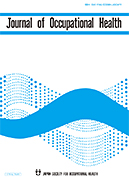Volume 59, Issue 6
Displaying 1-12 of 12 articles from this issue
- |<
- <
- 1
- >
- >|
Special Article
-
2017 Volume 59 Issue 6 Pages 471-476
Published: November 20, 2017
Released on J-STAGE: November 25, 2017
Advance online publication: October 18, 2017Download PDF (118K) Full view HTML
Review
-
2017 Volume 59 Issue 6 Pages 477-494
Published: November 20, 2017
Released on J-STAGE: November 25, 2017
Advance online publication: October 07, 2017Download PDF (184K) Full view HTML
Originals
-
2017 Volume 59 Issue 6 Pages 495-505
Published: November 20, 2017
Released on J-STAGE: November 25, 2017
Advance online publication: August 24, 2017Download PDF (217K) Full view HTML -
2017 Volume 59 Issue 6 Pages 506-512
Published: November 20, 2017
Released on J-STAGE: November 25, 2017
Advance online publication: August 24, 2017Download PDF (108K) Full view HTML -
2017 Volume 59 Issue 6 Pages 513-520
Published: November 20, 2017
Released on J-STAGE: November 25, 2017
Advance online publication: August 31, 2017Download PDF (100K) Full view HTML -
2017 Volume 59 Issue 6 Pages 521-528
Published: November 20, 2017
Released on J-STAGE: November 25, 2017
Advance online publication: October 07, 2017Download PDF (534K) Full view HTML -
2017 Volume 59 Issue 6 Pages 529-541
Published: November 20, 2017
Released on J-STAGE: November 25, 2017
Advance online publication: September 13, 2017Download PDF (245K) Full view HTML -
2017 Volume 59 Issue 6 Pages 542-551
Published: November 20, 2017
Released on J-STAGE: November 25, 2017
Advance online publication: October 07, 2017Download PDF (301K) Full view HTML -
2017 Volume 59 Issue 6 Pages 552-561
Published: November 20, 2017
Released on J-STAGE: November 25, 2017
Advance online publication: October 07, 2017Download PDF (211K) Full view HTML -
2017 Volume 59 Issue 6 Pages 562-571
Published: November 20, 2017
Released on J-STAGE: November 25, 2017
Advance online publication: October 07, 2017Download PDF (116K) Full view HTML
Field Studies
-
2017 Volume 59 Issue 6 Pages 572-580
Published: November 20, 2017
Released on J-STAGE: November 25, 2017
Advance online publication: October 07, 2017Download PDF (713K) Full view HTML -
2017 Volume 59 Issue 6 Pages 581-585
Published: November 20, 2017
Released on J-STAGE: November 25, 2017
Advance online publication: September 13, 2017Download PDF (86K) Full view HTML
- |<
- <
- 1
- >
- >|
